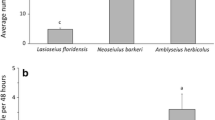Abstract
The two-spotted spider mite, Tetranychus urticae Koch, is a major pest in hops with world-wide economic importance. According to official guidelines, the monitoring of the infestation level of T. Urticae is done in Germany as well as the rest of Europe by exact counts of living spider mites per hop leaf, while numbers above 50 or 100 mites per leaf, respectively, are estimated roughly. This monitoring approach is very time-consuming, requires good diagnostic knowledge to identify younger developmental stages, may overestimate the true infestation level if mean values include high outliers, and, most important, spider mite eggs on the leaves are not considered at all.
Therefore, a six-stage pest index was developed during the years 1998–2000 in order to facilitate field monitoring of T. Urticae, in particular for hop growers. With this new monitoring method, numbers of living mites are assigned to different abundance classes, and deposited eggs on the leaves are considered additionally. This approach proved to be easy to handle, and was reliable during a further three-years’ testing period.
Zusammenfassung
Die Gemeine Spinnmilbe, Tetranychus urticae Koch, ist im Hopfenbau einer der beiden Hauptschädlinge mit weltweiter Bedeutung. In Deutschland wie auch dem Rest von Europa werden die Bonituren zur Ermittlung der Befallssituation von T. Urticae nach amtlichen Richtlinien bislang durch das exakte Auszählen lebender Spinnmilben pro Hopfenblatt durchgeführt. Bei Dichten von mehr als 50 bzw. 100 Tieren pro Blatt werden die Zahlen geschätzt. Diese Boniturmethode ist sehr zeitaufwendig, erfordert gute diagnostische Kenntnisse zur genauen Ansprache auch jüngerer Entwicklungsstadien der Art, birgt bei der Bildung von Mittelwerten die Gefahr der falschen Einschätzung der tatsächlichen Befallssituation durch sehr hohe Ausreißerzahlen, und zudem werden die auf den Blättern abgelegten Eier der Spinnmilben nicht berücksichtigt.
Da im Rahmen eines Bekämpfungsschwellenmodells für T. Urticae im Hopfenbau eine auch für Praktiker leichter zu handhabende und prognostisch besser verwertbare Boniturmethode erforderlich war, wurde im Anbaugebiet Hallertau in den Jahren 1998–2000 ein sechsstufiger Befallsindex entwickelt. Dabei wird die Anzahl lebender Spinnmilben pro Blatt in Abundanzklassen eingeteilt, und daneben werden auch die auf den Blättern abgelegten Eier berücksichtigt. Diese neue Boniturmethode erwies sich bei der anschließenden dreijährigen Überprüfung in der Praxis als ebenso einfach zu handhaben wie zuverlässig.
Similar content being viewed by others
Literature
Agnello, A. M., J. Kovach, J. P. Nyrop, W. H. Reissig, D. I. Vreth, W. F. Wilcox: Extension and evaluation of a simplified monitoring program in New York apples. — Am. Entomol. 40, 37–49, 1994.
Bode, E., W. Büchs, M. Fröschle, R. Kälberer, H.-Th. Kremheller, W. Riss, G. Schmid, U. Schmidt, K. Zürn: Richtlinien für die Prüfung von Pflanzenschutzmitteln im Zulassungsverfahren, Teil II: 6-4.1, Akarizide gegen Spinnmilben im Hopfenbau (Tetranychus urticae Koch). — Biologische Bundesanstalt für Land- und Forstwirtschaft, Abteilung für Pflanzenschutzmittel und Anwendungstechnik, Braunschweig, 1993.
Eppo [European and Mediterranean Plant Protection Organization]: Eppo Standard Pp 1/216 (1), Guidelines for the efficacy evaluation of acaricides: Tetranychus urticae on hop. — Eppo, Paris, 2001.
Freier, B., W. Karg: Regressionsmodelle für die Schnellbonitur des Spinnmilbenbefalls in Apfelanlagen. — Z. angew. Entomol. 105, 48–52, 1988.
Hepworth, G., J. R. MacFarlane: Systematic presence-absence sampling method applied to twospotted spider mite (Acari: Tetranychidae) on strawberries in Victoria, Australia. — J. econ. Entomol. 85, 2234–2239, 1992.
Hergstrom, K., R. Niall: Presence-absence sampling of twospotted spider mite (Acari: Tetranychidae) in pear orchards. — J. econ. Entomol. 83, 2032–2035, 1990.
Jones, V. P.: Sampling and dispersion of the twospotted spider mite (Acari: Tetranychidae) and the western orchard predatory mite (Acari: Phytoseiidae) on tart cherry. — J. econ. Entomol. 83, 1376–1380, 1990.
Margolies, D. C., E. P. Lampert, G. G. Kennedy: Sampling programs for the twospotted spider mite (Acari: Tetranychidae) in peanut. — J. econ. Entomol. 77, 1024–1028, 1984.
Neve, R. A.: Hops. — Chapman & Hall, London, 1991.
Nyrop, J. P., M. R. Vinns: Algorithms for computing operating characteristic and average sample number functions for sequential sampling plans based on binomial count models and revised plans for European red mite (Acari: Tetranychidae) on apple. — J. econ. Entomol. 85, 1253–1273, 1992.
Opit, G. P., D. C. Margolies, J. R. Nechols: Within-plant distribution of twospotted spider mite, Tetranychus urticae Koch, (Acari: Tetranychidae), on ivy geranium: development of a presence-absence sampling plan. — J. econ. Entomol. 96, 482–488, 2003.
Raworth, D. A.: Sampling statistics and a sampling scheme for the twospotted spider mite, Tetranychus urticae (Acari: Tetranychidae), on strawberries. — Can. Entomol. 118, 807–814, 1986.
Weihrauch, F.: Entwicklung einer Bekämpfungsschwelle für die Gemeine Spinnmilbe Tetranychus urticae Koch, 1836 (Acari, Tetranychidae) in der Sonderkultur Hopfen. — Logos-Verlag, Berlin, 2003.
Wright, L. C., W. W. Cone: Binomial sequential sampling plans for adult female twospotted spider mites (Acari: Tetranychidae) on hops. — J. econ. Entomol. 92, 1335–1343, 1999.
Author information
Authors and Affiliations
Corresponding author
Rights and permissions
About this article
Cite this article
Weihrauch, F. A new monitoring approach for the two-spotted spider mite Tetranychus urticae Koch (Acari: Tetranychidae) in hop culture. J Plant Dis Prot 111, 197–205 (2004). https://doi.org/10.1007/BF03356147
Received:
Accepted:
Published:
Issue Date:
DOI: https://doi.org/10.1007/BF03356147




